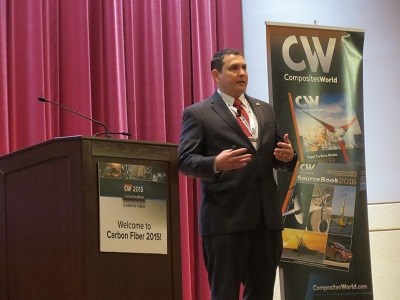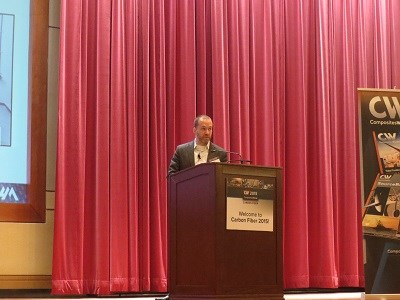Highlights from Carbon Fiber 2015
Carbon Fiber 2015 once again offered an engaging roster of speakers, and some eye-opening presentations.
Share
Read Next

John Russell of AFRL challenged the audience to deliver composite materials with better performance for the military aircraft "niche"
As with every Carbon Fiber conference, director Scott Stephenson put together an engaging roster of speakers for the 2016 edition of the event, held in Knoxville, TN, US at the Knoxville Convention Center from December 7 - 9. Each speaker brought up compelling issues related to carbon fiber, its applications, and more broadly, how to better process it at a lower cost while maintaining quality — and being able to verify and document that quality. The event had an automotive slant, given its location near the Knoxville headquarters of the Institute for Advanced Composites Manufacturing Innovation (IACMI). The Institute was one of the event’s sponsors, as well as the organizer of the first day’s informal panel discussion.
Many of the presentations were eye-openers for me. John Russell of the Air Force Research Laboratory (AFRL, Wright-Patterson AFB, OH, US) pointed out during his presentation, entitled: “Carbon Fiber Composites for Next Generation Military Aircraft,” that military aerospace has become a “niche application.” That seems hard to believe, if you have been in the industry long enough to remember the F-22’s development and the excitement of the JSF program. Russell pointed out that any military program today can’t really drive the composites market anymore, given a total build of fewer than 100 for potential future aircraft and the fact that a military aircraft’s airframe is a “minor” part of overall cost, which is dominated by electronic systems and weaponry. Another hurdle for composites in military aerospace is that certification methods for the aircraft are stuck in the 1960s, and it’s hard to fit next-generation composites into that metal-centric certification framework. Nevertheless, he believes composites will play a role in both airframes and turbine engines to meet speed, range and payload requirements for future aircraft. In that light, Russell challenged the audience to come up with a composite system with a 25% improvement in notched properties and with better thermal performance, for large parts. For smaller parts, the DARPA is looking for moldable, stampable materials with short fiber reinforcement that can still deliver high performance as well as flexible forming options.
Ryan Williams, senior scientist at N12 Technologies (Cambridge, MA, US), followed soon after Russell, asserting that his company’s material is capable of delivering on Russell’s goal of significantly better notched properties. N12 produces vertically-aligned carbon nanotubes (VACNTs) trademarked NanoStitch, which it combines with conventional prepregs to form a “hybrid” nanocomposite. The VACNTs are grown, at a thickness of 10 microns, in a continuous process that produces a vertical “forest” of vertically aligned nanofibers on a tape, or they can be directly grown on a prepreg. In a laminate stack, the NanoStitch layer in essence “stitches” adjacent prepreg plies together. Williams says that when cured, the hybrid composite material exhibits higher shear properties, with a 10% improvement in open-hole compression tests and up to 30% better modulus, along with significantly better impact and fatigue performance, compared to non-nano-enhanced prepreg. “The ply interface is actually stronger than the carbon fiber plies,” says Williams. NanoStitch also suppresses delamination in a laminate, and can also be used selectively for local reinforcement. N12 has also shown that its material provides through-thickness electrical conductivity; has successfully applied NanoStitch to thermoplastics; has shown the material can work as a surfacing film for ice detection or protection; and that it might enable in situ damage detection. CW’s Ginger Gardiner has previously blogged about this exciting material, and much more information is available at this page link: http://www.compositesworld.com/blog/post/the-end-of-delamination.
Recycling was a topic that came up in several presentations. Tassilo Witte of the Composite Technology Center Stade (CTC, Stade, Germany, an Airbus company) discussed Airbus’ efforts to meet the directives of the European Union’s “Circular Economy,” which aims to significantly increase recycling and reuse while reducing landfill waste to a minimum. With a mantra of “Reduce, Re-use, Recycle, Recover and Dispose (as a last resort),” Witte revealed some of the initiatives underway at Airbus, which include reducing trim allowances, more net-shape production and better use of nesting and kitting on the production floor. Remarking that finding solutions for recovered waste and recycled fibers is “fun,” Witte’s group at CTC has produced a carbon fiber/phenolic veil prepreg for aircraft interiors, using recycled fibers from a pyrolysis recovery system. The veil product, made into interior panel products, weighs 18% less than comparable glass fiber products currently used. He ended his presentation saying that the recycling process is producing “piles” of fiber, for which CTC is trying to develop applications.
Serendipitously it seemed, Witte was followed by Riley Reese, materials scientist at Arevo Labs (Santa Clara, CA, US). Arevo is developing robust additive manufacturing technology and software to produce high-performance carbon fiber reinforced composite parts, and is currently working as a service bureau. Its Reinforced Filament Fusion process can use continuous or chopped carbon fiber to make three-dimensional parts, at a lower cost than sintering machines, says Reese. The process aligns the chopped fibers along the bead, for tailored performance properties — and represents a potentially big application for recycled discontinuous carbon fiber. Here’s a link to a recent CW story on Arevo: http://www.compositesworld.com/products/arevo-labs-launches-3d-printing-platform-for-composite-parts-fabrication.

Truman Bonds of RMX Technologies announced the commercialization of a new plasma oxidation oven in partnership with C.A. Litzler
Another eye-opener was the announcement, by Truman Bonds of RMX Technologies (Knoxville, TN, US) of a collaboration with C.A. Litzler Co. Inc. (Cleveland, OH, US) and acrylic fiber producer Dralon GmbH (Lingen, Germany), which has resulted in a successful plasma oxidation oven. The new oven technology, which will be marketed by a subsidiary company called 4M Industrial Oxidation, reportedly can oxidize polyacrylonitrile (PAN) precursor fiber three times faster than current ovens, and uses 75% less energy than gas or electric-powered oxidation ovens. A long-time partner with Oak Ridge National Laboratory (ORNL), RMX has been investigating the plasma technology for years, but says that development is now complete and it is focused strictly on commercialization. “Plasma is a proven technology with multiple precursors,” says Bonds, “and we can show that it reduces the manufacturing cost of carbon fiber by 20%.” The technology is reportedly highly scalable and Litzler is gearing up to offer ovens to potential customers. A key point that caught audience attention was that, in addition to the significantly lower energy usage, and higher speed, the plasma oven takes up less room; it is one-third the length of conventional oxidation ovens, which could enable smaller fiber production facility size. Bonds also revealed that it is working with Dralon on a high-strength precursor fiber that is tailored specifically for the plasma process. The precursor reportedly can deliver 600 ksi carbon fiber, because of accelerated translation of properties from fiber skin toward the fiber core. Dan Miller, ORNL's manager of industrial partnerships and economic development, told CW that "ORNL and DOE are excited to see this technology take the steps toward fully deployment, from the work that has been done here starting with the basic science."
The informal panel, chaired by Dale Brosius, IACMI’s chief commercialization officer and a CW contributor, included IACMI’s CEO Craig Blue; Dan Beattie of Dow Chemical (Midland, MI, US); Steve Nolet of TPI Composites (Scottsdale, AZ, US); Brian Laufenburg of Chomarat (Le Cheylard, France and Williamston, SC, US); Uday Vaidya, IACMI’s chief technology officer; and Kelly Visconti, technology manager of the U.S. Department of Energy’s (DOE) Advanced Manufacturing Office, which is supporting, in part, IACMI’s composites development efforts. After Blue’s brief overview of the consortium’s structure, Brosius asked some hard questions, the first of which was, “Is this consortium needed, given the presence of others already established in the U.S.?” Beattie pointed out that from Dow’s perspective, there is a need for this sort of close, cooperative network for future market growth, and that “to succeed we need a platform for partnerships.” TPI’s Nolet added that “Manufacturing is the key word. We can’t solve manufacturing challenges without creativity and multi-disciplinary approaches with many stakeholders.” In response to an audience member who asked “Where do you want to be five years from now?” Blue answered that by that time he envisions a large and robust supply chain, with all facets of the composites industry involved. Nolet half-jokingly said his vision is a “lights-out” wind blade factory, fully automated, with clear paths established for recycling and reuse of materials. Another audience member pointed out that the current composites industry is fragmented with many small businesses, and asked how a small enterprise can benefit from IACMI? Blue answered that part of IACMI’s plan is technical collaboration, along the lines of ORNL’s Manufacturing Demonstration Facility, and he intends to involve small and medium enterprises (SMEs) who have unique equipment or skills in the consortium.
Related Content
CirculinQ: Glass fiber, recycled plastic turn paving into climate solutions
Durable, modular paving system from recycled composite filters, collects, infiltrates stormwater to reduce flooding and recharge local aquifers.
Read MoreWatch: A practical view of sustainability in composites product development
Markus Beer of Forward Engineering addresses definitions of sustainability, how to approach sustainability goals, the role of life cycle analysis (LCA) and social, environmental and governmental driving forces. Watch his “CW Tech Days: Sustainability” presentation.
Read MorePlant tour: Middle River Aerostructure Systems, Baltimore, Md., U.S.
The historic Martin Aircraft factory is advancing digitized automation for more sustainable production of composite aerostructures.
Read MorePlant tour: Arris Composites, Berkeley, Calif., U.S.
The creator of Additive Molding is leveraging automation and thermoplastics to provide high-volume, high-quality, sustainable composites manufacturing services.
Read MoreRead Next
Plant tour: Daher Shap’in TechCenter and composites production plant, Saint-Aignan-de-Grandlieu, France
Co-located R&D and production advance OOA thermosets, thermoplastics, welding, recycling and digital technologies for faster processing and certification of lighter, more sustainable composites.
Read MoreAll-recycled, needle-punched nonwoven CFRP slashes carbon footprint of Formula 2 seat
Dallara and Tenowo collaborate to produce a race-ready Formula 2 seat using recycled carbon fiber, reducing CO2 emissions by 97.5% compared to virgin materials.
Read MoreDeveloping bonded composite repair for ships, offshore units
Bureau Veritas and industry partners issue guidelines and pave the way for certification via StrengthBond Offshore project.
Read More






















